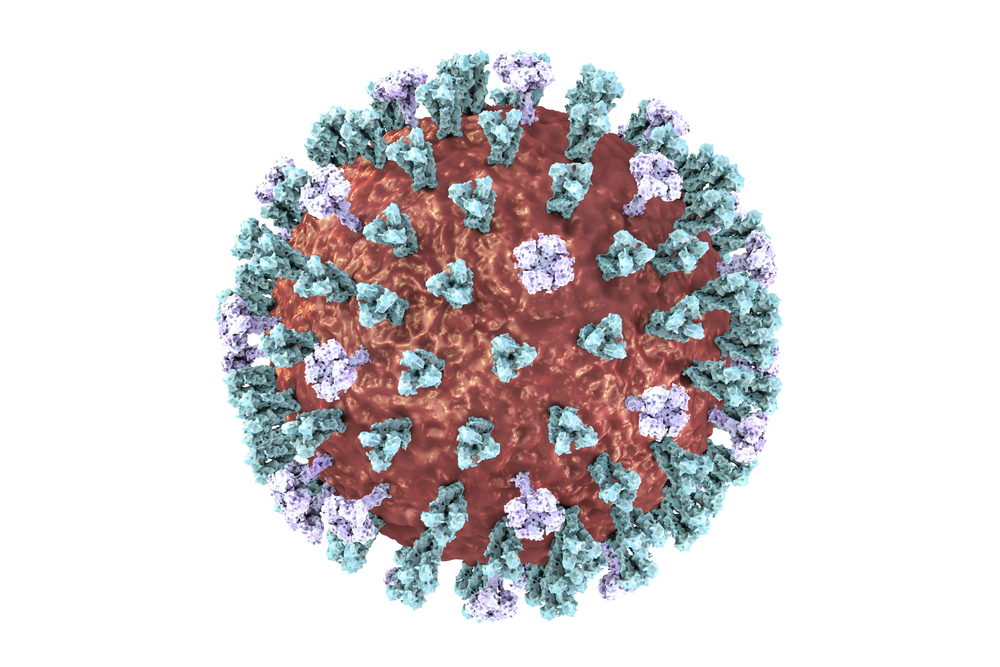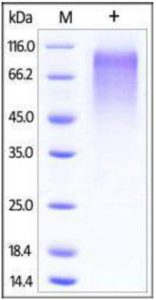SDS-PAGE: HRSV (A) Glycoprotein G on SDS-PAGE under reducing condition. The gel was stained overnight with Coomassie Blue. RSV-G is fused with a polyhistidine tag at the C-terminus, and has a calculated MW of 26.2 kDa. The reduced protein migrates as 60-94 kDa in SDS-PAGE due to glycosylation. Purity of the protein is greater than 90%.
Respiratory Syncytial Virus A Glycoprotein G (RSV A gG)
Price range: $1,318.00 through $6,526.07 excl. VAT
Recombinant Respiratory Syncytial Virus A glycoprotein G, comprising amino acids 67-297, and incorporating a C-terminal 6xHis tag, produced in mammalian HEK293 cells.
RESPIRATORY SYNCYTIAL VIRUS A GLYCOPROTEIN G (RSV A gG)
This Human RSV (A) glycoprotein G comprises His 67 – Arg 297 (Accession # P20895) from the Long strain, and is fused with a polyhistidine tag at the C-terminus. The total calculated MW is 26.2kDa. The RSV A gG protein is expressed in HEK293 cells, and reduced protein migrates as a band of 60-94kDa.
PRODUCT DETAILS – RESPIRATORY SYNCYTIAL VIRUS A GLYCOPROTEIN G (RSV A gG)
- Recombinant RSV A glycoprotein G expressed from HEK293 cells (NCBI Accession Number: P20895).
- Includes amino acids 67-297 and a C-terminal His-tag.
- Greater than 90% purity by SDS-PAGE and buffered in PBS, pH7.4.
BACKGROUND
Human Respiratory Syncytial Virus (RSV) is a single-stranded RNA virus, which was first isolated in 1956 from a laboratory chimpanzee with a respiratory illness and was later discovered to be of human origin. RSV consists of two antigenic subtypes, A and B. Subtype B tend to produce asymptomatic infections, whilst the more severe illnesses which predominate during outbreaks are associated with subtype A strains. RSV is the leading cause of lower respiratory tract infections, including pneumonia and bronchiolitis in young infants. Approximately two thirds of infants are infected with RSV within their first year and 90% have been infected by the age of 2. It may cause mortality or morbidity in the elderly as well as immunodeficient individuals. It is the most common pathogen leading to hospitalization in young children up to the age of 5.
The virion of Respiratory Syncytial Virus (RSV) contains three surface glycoproteins, the attachment protein G, fusion protein F, and the small hydrophobic SH protein. Glycoprotein G is a type II transmembrane glycoprotein and is the major RSV attachment protein. It contains a single hydrophobic region which serves as a signal peptide and also as a membrane anchor. The structure and function of RSV glycoproteins has been reviewed by McClellan et al (2013).
****SHIPPING AND STORAGE NOTIFICATION: This recombinant protein has been lyophilised to maximise stability. It is shipped at ambient temperature, and may be stored for up to 1 year at 4C prior to reconstitution. Following reconstitution, it should be stored at -80C. Extensive stability tests have shown no negative effects on antigen performance for 7 days of shipping at ambient temperature.


